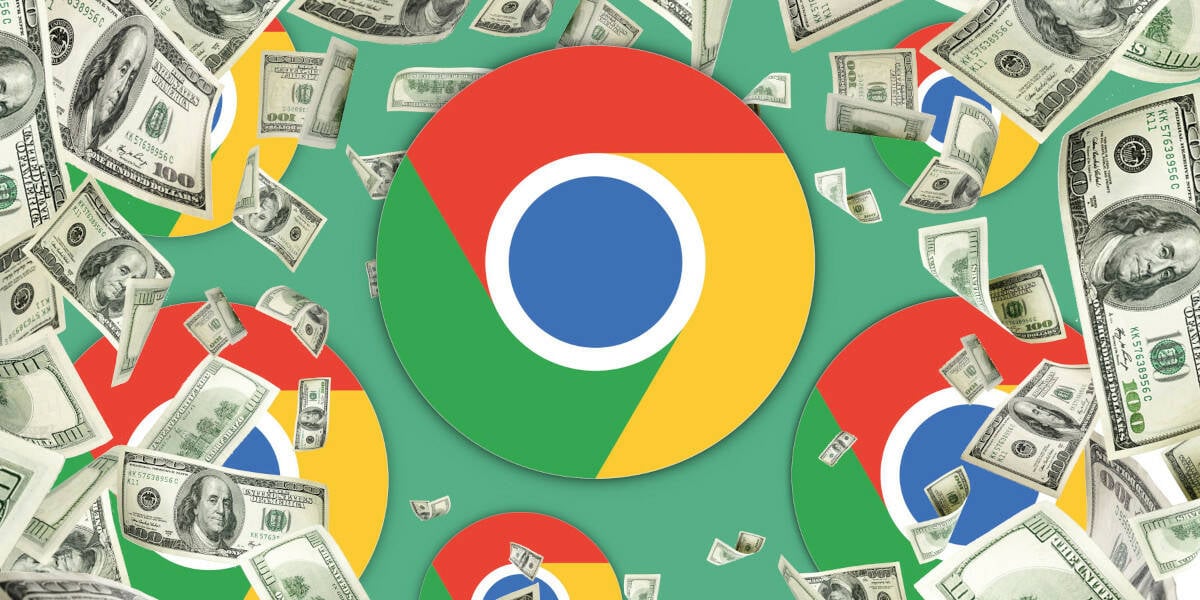Chrome Engine Devs Experiment With Automatic Browser Micropayments

The team behind Chromium – the open source engine of Google Chrome and other browsers – is working on a way to enable those surfing the web to pay for the stuff they read or watch without any interaction.
Earlier this month, Alexander Surkov, a software engineer at open source consultancy Igalia, announced the Chromium team's intent to prototype Web Monetization, an incubating community specification that would let websites automatically receive payments from online visitors, as opposed to advertisers, via a web browser and a designated payment service.
"Web monetization is a web technology that enables website owners to receive micro payments from users as they interact with their content," Surkov wrote in an explanatory document published last summer.
"It provides a way for content creators and website owners to be compensated for their work without relying solely on ads or subscriptions. Notably, Web Monetization (WM) offers two unique features – small payments and no user interaction – that address several important scenarios currently unmet on the web."
Small payments, or micropayments, have been developed and implemented in various forms and with varying degrees of success since the internet became a thing in the 1990s. And they were contemplated before that as part of Ted Nelson's Project Xanadu.
Two decades ago there was considerable skepticism they'd ever work. In 1999, cryptocurrency pioneer Nick Szabo argued [PDF] that the mental cost of dealing with tiny transactions usually exceeds or dwarfs the computation cost.
A few years later, in a 2003 paper [PDF], "The Case Against Micropayments," Andrew Odlyzko, presently a professor in the department of School of Mathematics at the University of Minnesota, wrote, "Micropayments are the technology of the future, and always will be."
Given the recent history of cryptocurrencies, decentralized finance, blockchains, digital wallets, in-app purchasing, and mainstream payment options like PayPal, Stripe, Venmo, and Zelle, there's certainly no shortage of attempts to prove otherwise. None of these really handle tiny transactions of a few cents very efficiently, however.
- Loose-change payment network Microraiden launches on Ethereum
- Google's gatekeeper to collect toll for dying news orgs
- Wall Street Journal wants your micro-payments
- YouTube and Micropayments
Brave Software in 2017 launched its Basic Attention Token (BAT), which in 2019 became part of its Brave Rewards program as a way to reward web users for viewing ads, have a way to share revenue with publishers. Among 28,000 websites presently participate, according to BuiltWith.
Search startup Mojeek started offering support for Web Monetization in 2021, through Coil, a blogging platform created in 2018 by former Ripple CTO Stefan Thomas. And it didn't work, at least for Coil which shut down about a year ago.
But in its farewell note, the startup handed the torch to the Interledger Foundation, which aims to enable Web Monetization via the Interledger Protocol and the Open Payments API.
The way ahead?
"Open Payments API is an open HTTP-based standard created to facilitate micro transactions on the web," wrote Surkov.
"It is implemented by a wallet and enables the transfer of funds between two wallets. It leverages fine-grained access grants, based on GNAP (Grant Negotiation and Authorization Protocol), which gives wallet owners precise control over the permissions granted to applications connected to their wallet."
The basic idea is web users will get a digital wallet, provided by Gatehub and Fynbos presently, and web publishers will add a link tag to their site's <head> block formatted like so: <link rel="monetization" href="https://wallet.example/alice" />.
Thereafter, site visitors who have linked their digital wallet to their browser will pay out funds to the requesting publisher, subject to the browser's permissions policy.
According to Surkov, Apple and Google have both shown support for Web Monetization, while Mozilla has shown more limited interest. Implementing the specification in Chromium – which would make it available to Chrome, Microsoft Edge, Brave, and other Chromium-based browsers – should ensure the technology has enough distribution for experimentation. Before that happens, prototyping still needs to be completed and there's no set date for when that may be finished.
There are many barriers to micropayments, such as security, scalability, reliability, and transaction costs - to say nothing of the mental burden of assessing the fairness of a price paid in pennies.
Micropayments are still the technology of the future, but the future may be nearer than it appears. Research firm Forrester has predicted that in 2024, "Micropayments will break out of their niche and become an alternative to subscriptions."
Keep in mind that not long after Amazon went public in 1997, George Colony, founder and CEO of Forrester Research, referred to the online bookstore as as "Amazon dot toast." ®
From Chip War To Cloud War: The Next Frontier In Global Tech Competition
The global chip war, characterized by intense competition among nations and corporations for supremacy in semiconductor ... Read more
The High Stakes Of Tech Regulation: Security Risks And Market Dynamics
The influence of tech giants in the global economy continues to grow, raising crucial questions about how to balance sec... Read more
The Tyranny Of Instagram Interiors: Why It's Time To Break Free From Algorithm-Driven Aesthetics
Instagram has become a dominant force in shaping interior design trends, offering a seemingly endless stream of inspirat... Read more
The Data Crunch In AI: Strategies For Sustainability
Exploring solutions to the imminent exhaustion of internet data for AI training.As the artificial intelligence (AI) indu... Read more
Google Abandons Four-Year Effort To Remove Cookies From Chrome Browser
After four years of dedicated effort, Google has decided to abandon its plan to remove third-party cookies from its Chro... Read more
LinkedIn Embraces AI And Gamification To Drive User Engagement And Revenue
In an effort to tackle slowing revenue growth and enhance user engagement, LinkedIn is turning to artificial intelligenc... Read more

